Ian Green's Fuzz to Folk autobiography makes a great and varied read. The story of a man of all trades - founder of Greentrax, Scotland's most successful and one of the world's greatest folk music labels, successful gardener, soldier and mechanic serving in Korea, policeman, angler and and and...
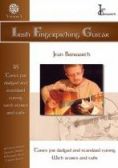 Guitarist Jean Banwarth
is the co-founder of French bands such as Djal
[27]
and Dedale [25].
Banwarth is following close on the heels of the McManus and Sibéril DVDs
[43,44]
with a fingerpicking guitar tutorial for Celtic music.
The 18 tunes - with staff notes and tabs -
kick off with a mazurka, which is introducing the DADGAD tuning
and should be no problem for fingerpickers, even for the uninitiated.
Then it's standard tuning with "The Blackbird",
originally a hornpipe (listen e.g. to the Red Wellies
[40],
here rewritten as a 6/8 air. Next is in both DADGAD and standard tuning
(even better dropped D) the strathspey/highland
"Bó Mhín na Toitean", inspired by Altan
[31].
There's the reel "Cregg's Pipes" with plenty ornaments inspired by Lunasa
[27],
both "Eddie Kelly's Reel" and the "Rights Of Man" hornpipe are considerably slowed down,
along the way incorporating hammering, pulling, slides.
"Speed the Plough" [44]
features a thumb triplet in Tony McManus style (upward strike).
With a Carolan tune, an American song, a gavotte and a klezmer piece taken from the first
Lunasa album [5]
(I myself recorded "Itzkel Frejlech" though I played only rhythm guitar then),
it is a very comprehensive and eclectic method - and thankfully bilingual French and English.
Guitarist Jean Banwarth
is the co-founder of French bands such as Djal
[27]
and Dedale [25].
Banwarth is following close on the heels of the McManus and Sibéril DVDs
[43,44]
with a fingerpicking guitar tutorial for Celtic music.
The 18 tunes - with staff notes and tabs -
kick off with a mazurka, which is introducing the DADGAD tuning
and should be no problem for fingerpickers, even for the uninitiated.
Then it's standard tuning with "The Blackbird",
originally a hornpipe (listen e.g. to the Red Wellies
[40],
here rewritten as a 6/8 air. Next is in both DADGAD and standard tuning
(even better dropped D) the strathspey/highland
"Bó Mhín na Toitean", inspired by Altan
[31].
There's the reel "Cregg's Pipes" with plenty ornaments inspired by Lunasa
[27],
both "Eddie Kelly's Reel" and the "Rights Of Man" hornpipe are considerably slowed down,
along the way incorporating hammering, pulling, slides.
"Speed the Plough" [44]
features a thumb triplet in Tony McManus style (upward strike).
With a Carolan tune, an American song, a gavotte and a klezmer piece taken from the first
Lunasa album [5]
(I myself recorded "Itzkel Frejlech" though I played only rhythm guitar then),
it is a very comprehensive and eclectic method - and thankfully bilingual French and English.
Jean Banwarth, Irish Fingerpicking Guitar Vol. 1.
MusTraDem MTD 1037,
2010, ISBN 978-2-9509470-9-3, pp32, €20,00 (incl. CD).
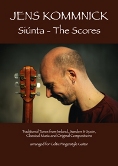 Anyone who made it through Banwarth's will find it easier dealing with
Jens Kommnick's compositions & arrangements.
The multi instrumentalist, first and foremost a guitar player, is performing with
Peter Kerlin [31] and
Iontach [34];
in 2008 he recorded his solo album "Síúnta"
[38],
and now presents its transcriptions - with slight variations to the recordings:
8 original tracks, Irish, Asturian and Swedish tunes, as well as a lute composition by
John Dowland and last but not least Telemann's Concerto in D major for 4 violins arranged
for 4 Irish bouzoukis. Jens plays Celtic Fingerstyle Guitar with a very unique and particular style,
mainly in DADGAD tuning, and beginners should think twice before lifting a finger.
The staff notes are clearly laid out (not always self-evident) and there are tabs as well.
Anyone who made it through Banwarth's will find it easier dealing with
Jens Kommnick's compositions & arrangements.
The multi instrumentalist, first and foremost a guitar player, is performing with
Peter Kerlin [31] and
Iontach [34];
in 2008 he recorded his solo album "Síúnta"
[38],
and now presents its transcriptions - with slight variations to the recordings:
8 original tracks, Irish, Asturian and Swedish tunes, as well as a lute composition by
John Dowland and last but not least Telemann's Concerto in D major for 4 violins arranged
for 4 Irish bouzoukis. Jens plays Celtic Fingerstyle Guitar with a very unique and particular style,
mainly in DADGAD tuning, and beginners should think twice before lifting a finger.
The staff notes are clearly laid out (not always self-evident) and there are tabs as well.
Jens Kommnick, Siúnta - The Scores.
Siúnta Music SM2205,
2010, ISBN 978-3-00-030972-4, pp48, €15,00.
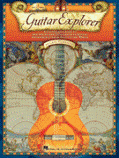 Of course, there is a realm beyond the Celtic. Guitarist
Greg Herriges
is looking beyond the rim of the teacup and
exploring styles and techniques from non-guitar traditions worldwide
for adventurous guitar players. There is the Chinese pipa
[38],
the Hawaiian ukulele and the West African kora (which influenced many African guitarists),
but is not restricted to lute-type instruments and includes
Indonesian gamelan percussion orchestras as well.
It would take a few lifetimes to study all the intricacies of Indian music,
so we'll graze the tip of the iceberg here... What's true about the sitar is true
about this in general. He comes up with such exotic suggestions as
strumming with a short-bristled brush to resemble a Puerto Rican cuatro guitar.
He explores drone strings and ornaments, open tunings and uneven time signatures,
and imitating double courses with a single-course instrument.
The book - including staff notes, tabs and a CD - is for intermediate and advanced guitarists.
All in all, it shows you to approach your guitar from a different angle and
use your acquired skills to learn from other musical languages.
I certainly got some ideas and will try to work it into my songs.
Of course, there is a realm beyond the Celtic. Guitarist
Greg Herriges
is looking beyond the rim of the teacup and
exploring styles and techniques from non-guitar traditions worldwide
for adventurous guitar players. There is the Chinese pipa
[38],
the Hawaiian ukulele and the West African kora (which influenced many African guitarists),
but is not restricted to lute-type instruments and includes
Indonesian gamelan percussion orchestras as well.
It would take a few lifetimes to study all the intricacies of Indian music,
so we'll graze the tip of the iceberg here... What's true about the sitar is true
about this in general. He comes up with such exotic suggestions as
strumming with a short-bristled brush to resemble a Puerto Rican cuatro guitar.
He explores drone strings and ornaments, open tunings and uneven time signatures,
and imitating double courses with a single-course instrument.
The book - including staff notes, tabs and a CD - is for intermediate and advanced guitarists.
All in all, it shows you to approach your guitar from a different angle and
use your acquired skills to learn from other musical languages.
I certainly got some ideas and will try to work it into my songs.
Greg Herriges, Guitar Explorer - A Guitarist's Guide to the Styles and Techniques of Ethnic Instruments from Around the World.
Hal Leonard HL00695971,
2010, ISBN 978-1-4234-2356-0, pp71, €18,10 (incl. CD).
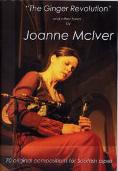 Let's put away the guitar and take up the bagpipes.
Well, actually any instrument you can play a Scottish tune with.
Joanne McIver from Arran off the west coast of Scotland
started writing tunes on her highland pipes, small pipes and flute
when she moved to France in 1994. These
bearing titles after Scottish places, people, and fond memories
- including Arran's football club which didn't win a match in 18 years.
She recorded four CDs with her husband and harpist Christophe Saunière
[35].
This tune collection features 70 of her own tunes -
marches, strathspeys, reels, slow airs, waltzes, jigs, hornpipes,
with staff notes including ornaments. Just a few examples which made me prick up my ear:
there's an animated jig called "Sauchiehall Street," aptly named after Glasgow's busiest shopping street,
where she used to busk as a student;
"The Sheep in the Sea" (Joanne's great great grandfather drowned
trying to save one of his sheep) and "John Loudon McAdam" of the "Scottish Inventors Suite"
are spirited hornpipes (which don't have very much of a hornpipe feel);
"The White Stag" is a haunting slow air, almost a piobaireachd.
Eventually, "The Clydeside Dockyards" leads into the rock fusion genre
mimicking the sounds of the Glasgow shipyards,
but mostly Joanne's tunes relate to the "Lochranza Distillery"
which uses only traditional methods and produces a very fine malt.
Let's put away the guitar and take up the bagpipes.
Well, actually any instrument you can play a Scottish tune with.
Joanne McIver from Arran off the west coast of Scotland
started writing tunes on her highland pipes, small pipes and flute
when she moved to France in 1994. These
bearing titles after Scottish places, people, and fond memories
- including Arran's football club which didn't win a match in 18 years.
She recorded four CDs with her husband and harpist Christophe Saunière
[35].
This tune collection features 70 of her own tunes -
marches, strathspeys, reels, slow airs, waltzes, jigs, hornpipes,
with staff notes including ornaments. Just a few examples which made me prick up my ear:
there's an animated jig called "Sauchiehall Street," aptly named after Glasgow's busiest shopping street,
where she used to busk as a student;
"The Sheep in the Sea" (Joanne's great great grandfather drowned
trying to save one of his sheep) and "John Loudon McAdam" of the "Scottish Inventors Suite"
are spirited hornpipes (which don't have very much of a hornpipe feel);
"The White Stag" is a haunting slow air, almost a piobaireachd.
Eventually, "The Clydeside Dockyards" leads into the rock fusion genre
mimicking the sounds of the Glasgow shipyards,
but mostly Joanne's tunes relate to the "Lochranza Distillery"
which uses only traditional methods and produces a very fine malt.
Joanne McIver, The Ginger Revolution - 70 Original Compositions for Scottish Pipes.
Buda Musique, 2011, pp78, €20,00 (www.mciversauniere.com).
 Addressing non-European artists who want to tour Europe and are in need of infos and contacts,
the French Traditional and World Music Information Centre
CIMT
and the German agency alba Kultur
have published a guide book and listed some 5,000 contacts to world music partners in Europe.
The Euro World Book has three parts - France, Germany, and 27 more European countries,
respectively. The European section features entries from Austria with
Euroots and the
Steirisches Volksliedwerk
to the UK with SAIN
and Topic Records.
The lists include promoters, managers, regional organisations, media, record companies,
festivals and venues. The German and French sections also have selected artist homepages.
Short essays in French, German and English introduce the world music scene in France and Germany and discuss
visa applications, work permits and fiscal laws (as of spring 2010).
The Euro World Book is in no way comprehensive but should serve Europeans and non-Europeans
alike to make their first few steps on the European trad, folk, roots and world music circuit.
Addressing non-European artists who want to tour Europe and are in need of infos and contacts,
the French Traditional and World Music Information Centre
CIMT
and the German agency alba Kultur
have published a guide book and listed some 5,000 contacts to world music partners in Europe.
The Euro World Book has three parts - France, Germany, and 27 more European countries,
respectively. The European section features entries from Austria with
Euroots and the
Steirisches Volksliedwerk
to the UK with SAIN
and Topic Records.
The lists include promoters, managers, regional organisations, media, record companies,
festivals and venues. The German and French sections also have selected artist homepages.
Short essays in French, German and English introduce the world music scene in France and Germany and discuss
visa applications, work permits and fiscal laws (as of spring 2010).
The Euro World Book is in no way comprehensive but should serve Europeans and non-Europeans
alike to make their first few steps on the European trad, folk, roots and world music circuit.
Euro World Book - The Road-Book to World Music.
irma,
2010, ISBN 978-2-916668-30-7, pp328, €37,00.
Ian Green's story starts in rural Morayshire, describing a life of the family of a head gardener on Scottish estates - a life in times gone by. Eventually, Ian takes up an apprenticeship as gardener with his Dad - but soon gets called up for army service and decides to sign up as a regular soldier. He ends up as an army mechanic in Korea, and the book tells vivid tales of his times there. Coming back from Korea, Ian decides to join the police force.
Quite a big, and for me one of the best, parts of the book tells of his 30 years as a policeman, given a fascinating account of working "on the beat" in Edinburgh in those times. This includes many anecdotes, some of them amusing, others more serious - but all well worth a read. And he succeeded in the police to eventually become an Inspector.
Interspersed into this story are his family life - marrying lovely June, having three children - and his various hobbies - successful speedway racer in his teens, angler (successful in competitions), gardener (including winning prizes at flower shows)...
And just when the reader thinks what an interesting and fulfilled life this was, and that time may have come for a restful retirement, the chapter that Ian is best known for, and the reason for most people to buy this book, starts: The Music years.
And these unfolded already in parallel to his police career (and have delayed his police promotion) - founding and running the highly respected Police Folk Club, plenty of fond and amusing accounts of festival visits, co-founding, co-editing and writing for Sandy Bell's Broadsheet (back then the respected folk magazine in Scotland), running a Discount Folk Mail Order, involved in starting and running Edinburgh Folk Club and Folk Festival... and then founding Greentrax.
This part of the book is full of well-known names of the Scottish folk scene, in fact some of the Greentrax years feature real name-dropping, with fond descriptions and short anecdotes of the various musicians on Greentrax, which is good fun to read if you know many of them. With a culmination of his music career, several hundred Greentrax albums later, being presented with an honarary degree of Doctor of Music by the Royal Academy of Music and Drama in Glasgow. There will be more about Greentrax in the next issue when we celebrate 25 years of Greentrax.
To give you a flavour of the book, we are pleased to be able to offer you an excerpt from the book - with kind permission of the publisher, Luath Press Ltd. In this excerpt Ian describes the start of his engagement in folk music...
"In the early ’60s, after I passed my police sergeant and inspector exams, June and I finally could afford our first black and white Bush tv. Almost everyone we knew had a tv by then, but with our meagre financial resources we were way behind the times, with only a mono radiogram to entertain us.
We were sitting watching ‘the box’ one night when a programme titled ‘Hootenanny’ appeared on the screen. We were treated to The Corrie Folk Trio and Paddy Bell, Rae and Archie Fisher, Eleanor Smith and Dolina McLennan. I was knocked out by the songs, some of which I immediately associated with my childhood years. I was hooked. I went out next day and bought my first lp – ‘Hootenanny Volume 1’ – and wore it out. I next added the very first Corrie Folk Trio and Paddy Bell album – ‘The Promise of the Day’ – and so started my love of traditional music, referred to usually as folk music, although I prefer the former. From those small beginnings my record collection grew and now includes hundreds of 78s, lps, music cassettes, cds, videos and dvds. I also have a collection of comedy albums – The Goon Show and Monty Python’s Flying Circus are examples – Tony Hancock is also a favourite. However, my insatiable appetite for traditional music became an obsession, or so my family assure me.
The logical next step was going to concerts, which included The Corrie Folk Trio, The Dubliners, The Clancy Brothers and Tom Paxton, followed by folk clubs and, later, folk festivals. I was introduced to the folk-club scene by my old friend Jimmy McCalman who happened to mention that The Ian McCalman Folk Group (later to change to The McCalmans because it was easier on the tongue) were doing the Triangle Folk Club. June and I went along and I was totally blown away. This led to visits to the Buffs Club, plus other venues, and because we now had ‘insider’ knowledge through The McCalmans, we were soon invited to a session in a ‘folky’ flat in Tollcross, the latest ‘pad’ of Hamish Bayne and Derek Moffat (of The McCalmans). Ian McCalman wisely advised us to buy a carry-out before the pub closed at 10 o’clock. (Remember those days?) Armed with some cans of beer and a quarter-bottle of vodka for June, we made our debut entrance to a ‘folk pad’. It was quite basic, with only a couple of seats which we were given the honour of sharing, but when June requested a glass to pour herself a vodka, this was greeted with roars of laugher and she had to settle for the one and only cup in the flat. What a night of great singing followed. It was still going strong when we left, I know not when.
The first festival we ever attended was the Kinross Festival, organized by the Traditional Music and Song Association, one of many wonderful weekends of music, fun and good companionship – washed down with copious amounts of booze, of course. That weekend will be forever etched in my memory. It was the first time I heard the wonderful voice of Heather Heywood and some of the tradition bearers, including Belle Stewart and Willie Scott.
That wasn’t enough. I needed to be part of this amazing scene. The Police Club at York Place in Edinburgh had recently opened its doors, and the committee was anxious to have functions in the club to attract members. The Police Angling Section (or Club), of which I was a member, was looking at ways to subsidise the cost of angling outings, and Davie Scougall, who also had an interest in folk music, especially Matt McGinn, and myself came up with the idea of running a folk night in the functions room. We charged a small entry fee (far too low) and, after paying the artists their expenses, some money went to the angling funds. The most amazing thing about that first evening was the interest generated within police circles. A decision was taken by the Angling Club Committee to run a weekly folk night. This was eventually reduced to a fortnightly event which became the Police Folk Club, later to be nicknamed ‘Fuzzfolk’. There was a committee member from each City Division, plus Head - quarters, the cid and Traffic Department. Each was responsible for selling tickets and the running of the club every second Sunday. ‘Fuzzfolk’ was immediately a huge success. It was the most popular event held in the Police Club and, quite rightly, in due course was regarded by folk artists and others as one of the best folk clubs in Scotland.
I took it in turn with Davie Scougall to act as compere, and we became the principal organisers. There were some other stalwarts of course – Jean Ferrier, Peter Ash, Tom Carlyon, Tom Shaw, Willie Cockburn and others. In an effort to maintain a succession of new artists, Davie and I often spent our own time ‘scouting’ for new ‘acts’.
I remember we went to a club in Dalkeith, at which Billy Connolly was doing an early solo gig after the break-up of The Humblebums. We invited Billy to ‘do’ the Police Club and he asked for the princely sum of twelve pounds. I am embarrassed to say we beat him down to eight, and I have the signed receipt to this day. Many years later, I mentioned this to Billy and he rightly commented it was probably not a bad fee in those days, but to this day I feel guilty about beating his fee down. He was to appear many more times at ‘Fuzzfolk’ and always attracted a full house.
A fellow policeman hosted the visit of a number of Royal Ulster Constabulary officers, on rest and recuperation from the ‘troubles’. He brought them along as guests on a Connolly night. Billy did ‘The Crucifixion’ to the enjoyment of all, including the ruc officers, but the host was upset and reported the Angling Club to the principal committee.
Davie and me were hauled over the coals, given a severe dressing down and warned not to invite him or any other ‘blasphemous’ artist to the club in future.
We waited a year for the dust to settle before we took the big risk of being shut down by cheekily inviting Billy back. We billed it as follows – ‘If you are easily offended then DO NOT attend this folk night’ and sold every ticket in a day. Billy went down a storm, especially in the second half after I told him I believed he was a ‘bit restrained’.
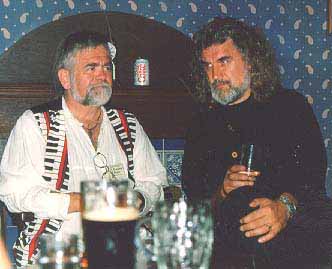 He agreed. He went out and did ‘The Crucifixion’ to the delight of all. Nothing was said by the ‘governing body’, so common sense won the day.
He agreed. He went out and did ‘The Crucifixion’ to the delight of all. Nothing was said by the ‘governing body’, so common sense won the day.
Billy, unfairly in my opinion, got a lot of stick from the press, but he impressed me greatly in relation to his final ‘Fuzzfolk’ gig. As always, he was booked a year ahead and meantime had rocketed to international stardom, mainly because of an appearance on The Michael Parkinson Show. I phoned Billy and said he could call off if he wished, principally because the money we were due to pay him (thankfully significantly more than the first fee we paid him) could not possibly compare with the fees he suddenly commanded. ‘No way,’ said Billy, ‘I accepted the booking and the fee offered and I will fulfil the promise. In any case, I like ‘Fuzzfolk’. It was the only place I was ever banned from.’ Good on you Billy.
The hunt to find new acts was continuous in the early days. I was on duty in the police patrol van one day when I spotted a car ahead of me exhibiting a sign advertising ‘The Cotters’ on the rear window. I knew of the duo and it was a rare chance to chat about a prospective booking. I followed the car for a mile or two until an opportunity occurred to flag down the driver, little realising that the occupant, Ali Watson of The Cotters, was by then ‘shitting his breeks’ because of the close police attention. When I explained my purpose for stopping him, the relief on his face was palpable and the incident became a Cotters’ stage story. Sadly, Ali and his partner Alex Sutherland both died of cancer at an early age. The Cotters were, in their time, the most popular group of the then flourishing folk-pub scene in Edinburgh."
This book is a cracking read and is highly recommended for folk fans and non-folk fans alike.
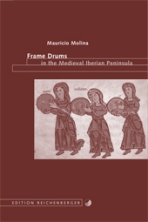
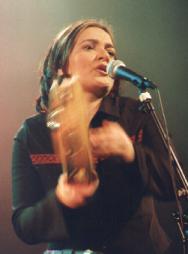 Hand-held frame drums[36]
were the most common percussion instruments in the medieval Iberian Peninsula.
Musicologist Mauricio Molina,
an early music performer with bands such as
Magister Petrus,
Sendebar and
Adufera, identifies two different types -
one of circular shape with parchment stretched over one side of its shell,
another of square shape with parchment covering both sides of its body.
These instruments - named tympanum in Latin,
or pandero, bandair, adufe or duff in Castilian and Arabic -
probably developed from skin trays and grain sieves.
Its widespread use during the Middle Ages is documented by depictions created between the
10th and 15th centuries, first Christian and Jewish manuscript illuminations,
later Christian and Islamic stone sculptures, paintings and woodcarvings.
Molina also draws on literary sources such as
descriptions in both Christian and Muslim chronicles and literary works.
He discusses physical aspects, the instruments' social functions and its repertory.
Although no medieval frame drum has survived, he attempted to recreate not only
performance practices and techniques but also the sound color and timbre
by studying structures (shell diameter, depth, thickness, addition of resonators such as snares and jingles)
and materials (animal skin turned into parchment as vibrating membrane, its thickness,
light-weight wooden bodies) and additionally drawing on modern frame drummers from rural areas in Spain
and Portugal and historically-related North Africa and Latin America.
His ambitious but convincing suggestion: medieval Iberian frame drums tended to produce a higher and brighter pitch than the larger frame drums
commonly used in modern traditional Iranian, Turkish, and Irish music.
With a wealth of pictures and an extensive bibliography Molina succeeded
to put frame drums, and percussion instruments in general, on the map of rigorous musicological research.
Hand-held frame drums[36]
were the most common percussion instruments in the medieval Iberian Peninsula.
Musicologist Mauricio Molina,
an early music performer with bands such as
Magister Petrus,
Sendebar and
Adufera, identifies two different types -
one of circular shape with parchment stretched over one side of its shell,
another of square shape with parchment covering both sides of its body.
These instruments - named tympanum in Latin,
or pandero, bandair, adufe or duff in Castilian and Arabic -
probably developed from skin trays and grain sieves.
Its widespread use during the Middle Ages is documented by depictions created between the
10th and 15th centuries, first Christian and Jewish manuscript illuminations,
later Christian and Islamic stone sculptures, paintings and woodcarvings.
Molina also draws on literary sources such as
descriptions in both Christian and Muslim chronicles and literary works.
He discusses physical aspects, the instruments' social functions and its repertory.
Although no medieval frame drum has survived, he attempted to recreate not only
performance practices and techniques but also the sound color and timbre
by studying structures (shell diameter, depth, thickness, addition of resonators such as snares and jingles)
and materials (animal skin turned into parchment as vibrating membrane, its thickness,
light-weight wooden bodies) and additionally drawing on modern frame drummers from rural areas in Spain
and Portugal and historically-related North Africa and Latin America.
His ambitious but convincing suggestion: medieval Iberian frame drums tended to produce a higher and brighter pitch than the larger frame drums
commonly used in modern traditional Iranian, Turkish, and Irish music.
With a wealth of pictures and an extensive bibliography Molina succeeded
to put frame drums, and percussion instruments in general, on the map of rigorous musicological research.
Mauricio Molina, Frame Drums in the Medieval Iberian Peninsula. Edition Reichenberger, 2010, ISBN 978-3-937734--71-2, pp198, €39,00.
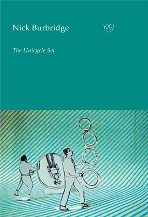 Focus, for a moment, on the left hand.
Focus, for a moment, on the left hand.Nick Burbridge, The Unicycle Set. Waterloo Press, ISBN 978-1-906742-28-7, pp83, £10.00.
 Irishman Mick Fitzgerald
leads different lives. Besides playing music,[39]
he is an actor and writer of short stories.
Irishman Mick Fitzgerald
leads different lives. Besides playing music,[39]
he is an actor and writer of short stories.
When Bill Clinton passed along our street on his way downtown from Dublin Airport, parking overnight was prohibited anywhere on the route ... At 7 a.m. [a little blue Fiat] was unceremoniously removed but not before a screaming Yuppie came charging out of one of the doors in a little night-dress ... The wind did wonderful things to her night-dress. Clinton would have been amused to say the least.
Though there are witty remarks - e.g. he had van Gogh's ear for music - Mick is not really a funny writer, rather exhibiting a deep humanity and a deep melancholy. His tales are often short vignettes, changing the point of view and coming full circle in the end. Don't expect any moral or punch line. It is about parting and moving on, sometimes only to travel to Germany, or even to eternal rest. A reunion is not envisioned. My personal favourite is "The Way the Money Goes", a farewell to a 20€ bill and its subsequent journey. Another example, tin whistle player John McGarth attends his Irish music session for the very last time, before embarking to America for a ready made job with great prospects and rich in-laws.[Fiction]
Yes, there is music in Mick's stories: the fiddle lesson sounds with the "Christmas Eve" reel and the slow air "Blind Mary" (harpers, guitarists and pipers love the latter), a soundtrack while reading. Let's conclude with another musical excerpt:
In the middle of a tune or a song you made longer than normal eye contact with a beautiful woman. I'm on to something here, you thought. Then from out of nowhere came the Great Authority on Irish music. He engaged her in conversation and probably even gave her your name and musical pedigree. As the night drew to a close inevitably you saw his arm going round her shoulder and that was the end of that ... He probably wouldn't know a bar of music from a bar of soap, was your final thought as you watched them leave together.
Mick's stories are available in English as well as in German translation.[43]
[Walkin' T:-)M]
Mick Fitzgerald, Session - Irish Stories. Songdog, 2010, ISBN 978-3-9502890-3-9, pp74, €12,00.
Photo Credits:
(1ff) Book Covers,
(2) Ian Green, 1985
(from website/author/publishers);
(3) Danny Kyle & Billy Connolly,
(4) Guadi Galego (by The Mollis).